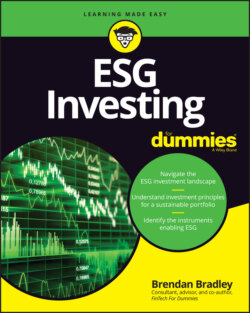Читать книгу ESG Investing For Dummies - Brendan Bradley - Страница 37
Crunch the numbers: Evolving data and analytics
ОглавлениеThe rapid growth in ESG investment strategies has been underpinned by the increasing availability of corporate sustainability metrics. Investors have embraced this information and integrated it into financial analyses and decisions. In addition, new technology, including artificial intelligence (AI) approaches, has allowed investors to run more enhanced analysis.
Investors are progressively applying non-financial factors as part of their analysis process to recognize material risks and growth opportunities. ESG metrics aren’t generally part of mandatory financial reporting, though companies are gradually including disclosures in their annual reports or in stand-alone sustainability reports. Also, institutions such as the Sustainable Accounting Standards Board (SASB) and the Global Reporting Initiative (GRI) are forming standards and defining materiality (a means of identifying which factors matter most for a specific company, from a wide and complex universe of sustainability indicators) to simplify incorporation of these factors into the investment process.
While the quality of these metrics is improving, many still question the reliability, consistency, and utility of such data. Agreeing on the broad principles of ESG is one thing, but having a standardized view of how one company ranks relative to another is a key component in comparing performance of companies and portfolios as ESG investing develops. The most important concerns include filling in gaps in the data, adding new metrics, and improving dependability, which improves comparability across companies. I discuss rankings and metrics in more detail later in this chapter.
The practice of reflecting ESG issues has evolved considerably from its origins in the negative or exclusionary screening of listed equities based on moral values. Some providers still focus on negative screening, where they exclude firms or sectors from investment portfolios, often on ethical or religious grounds (for example, tobacco, alcohol, ammunition, and gaming). Another common use case is limiting exposure to poor labor conditions, corruption, or other issues in the supply chain. A variety of methods are now being used that consider concerns for both purely investment-motivated and more values-motivated investors across asset classes. For example, ESG screens that identify what investors consider to be the worst-performing or “best in class” companies, in terms of their ESG score within a specific sector, are frequently applied. Yet providers don’t agree on which factors are most important, and much less data is available to help identify positive opportunities for sustainable investment. I discuss the ratings bias in more detail later in this chapter.
Composite ESG scores, where the individual elements of ‘E,’ ‘S,’ and ‘G’ are aggregated into one total score, can risk further reducing an investor’s understanding of a company and its real-world impact. A comparison of some major providers of ESG scores shows relative correlations of only 30 to 40 percent, depending on the period you’re looking at, which is rather low! This issue arises as different ratings agencies use different methodologies to arrive at both their individual and composite scores, including different metrics and weightings, so disparities will naturally exist. However, traditional investors don’t only look at a balance sheet when analyzing a company, and therefore they shouldn’t rely on a mixture of ESG scores, which they don’t really understand, to create a false sense of confidence. They need to focus on the quality and comparability of ESG information provided by corporate issuers, and determine how best to integrate various ESG factors into their investment selection process. Many active management investors have also begun to apply their own research perspectives on this scoring issue, leading to yet another set of results. See Chapter 14 for more about the integration of ESG performance in the investment process.
So, while consistency across ESG scores is needed, you also need heterogeneity of methodologies so that investors can decide what is more compelling for their ESG-related objectives. Moreover, in 2020 the EU Technical Expert Group (TEG) on Sustainable Finance published a taxonomy report for sustainable finance that aims to improve the coverage of disclosed data. Perhaps there will be a convergence of ratings, as seen in the credit ratings space since the 1960s, with agencies in that area keen to apply their current domain expertise to an ESG offering. There is also an increasing demand for real-time reporting around ESG issues to understand immediately what ESG-related risks investors have in their portfolios.
Clearly there is an ongoing race to provide a “single point of truth” platform for ESG data. An increasing number of providers are producing thousands of metrics and scores, either within their platforms or over an application programming interface (API). This further supports the use of AI, as it enables continuous, real-time, big data ESG harvesting and analytics. This should lead to the creation of stronger ESG investment signals, through sustainable ratings, that facilitate the creation of more forward-looking analysis rather than largely backward-looking corporate disclosure. The result could be the realization of transparent performance attribution analysis that correctly determines the premium on ESG investments. Whichever way, greater data quality and integrity are required.
You can visit www.researchaffiliates.com/en_us/publications/articles/what-a-difference-an-esg-ratings-provider-makes.html to review how different service providers apply their ratings. The physical scores or rankings offered by service providers are proprietary, but more of the ratings agencies are now providing indicative scores on their websites without the requirement to be a subscriber. One example is www.sustainalytics.com/esg-ratings/.
